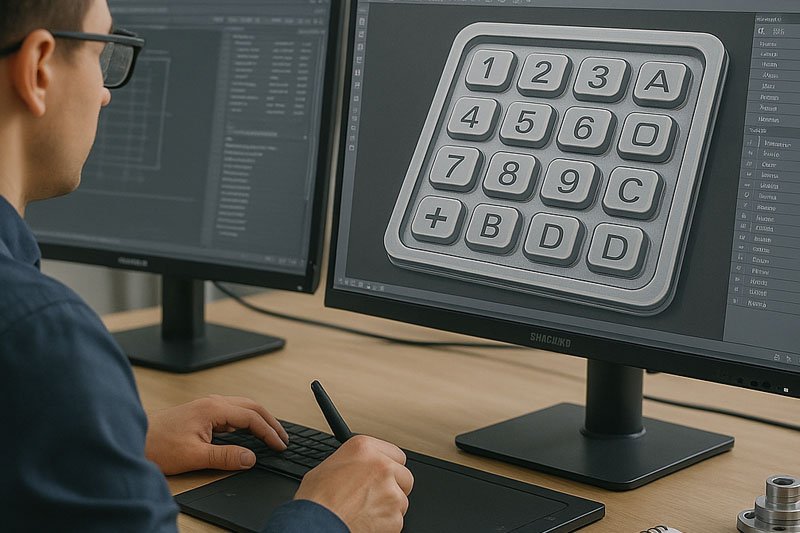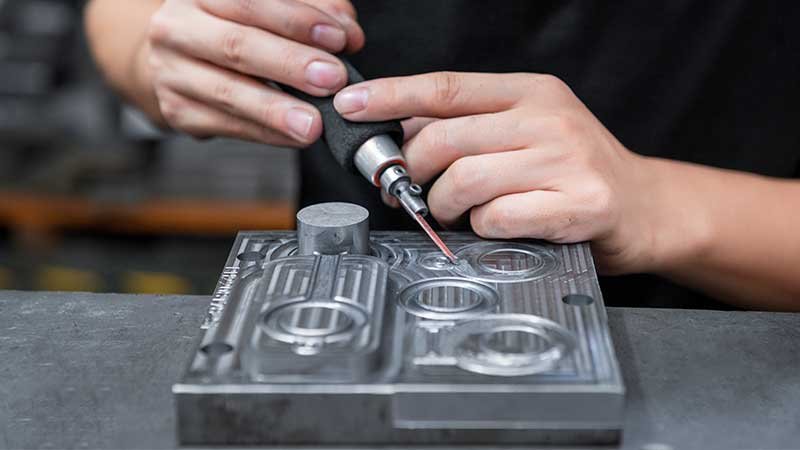The performance of a silicone keypad starts long before the first button is pressed—it begins with the tooling. The mold is the master blueprint.
Silicone keypad molds are engineered using precision machining and CAD design to ensure accurate shape, tactile response, and long-term production reliability.
Every perfect keypad starts with perfect tooling. At RuiYang Silicone, we’ve seen how a great mold leads to consistent quality—and how a flawed one leads to production headaches. Let me show you how we build molds that last millions of cycles.
What is the role of CAD in mold design?
Everything begins with a 3D model. It’s where design ideas turn into real production tools.
Computer-Aided Design (CAD) is used to create 2D and 3D models of the keypad, including key travel, webbing geometry, and overall fit. These guide the entire tooling process.

Our engineers create the mold based on your keypad design. The CAD file includes every detail: button height, key pitch, edge radius, and exact webbing shape. We simulate how silicone will flow, compress, and cure.
We also analyze undercuts, draft angles, and ejection points. A clear CAD model avoids tool revisions later, saving time and cost.
| CAD Elements | Purpose |
|---|---|
| Keypad 3D Model | Shows shape and dimensions |
| Webbing Geometry | Defines tactile feedback |
| Parting Line Design | Prevents flash or misalignment |
| Tooling Draft Angles | Helps easy de-molding |
A strong design foundation leads to fewer errors and faster production cycles.
How is the mold base selected and prepared?
Choosing the right mold base determines tool life and production efficiency.
Mold bases are typically made from hardened steel or aluminum. The material is selected based on production volume, precision, and durability.

For most production runs, we use P20 or H13 tool steel. These materials can endure high pressure and temperature over long runs. Aluminum is used for prototypes or small runs due to its quick machinability.
Before machining, we treat the material for hardness and polish the surface to avoid defects in the final keypad.
| Mold Material | Use Case | Benefits |
|---|---|---|
| P20 Steel | Mid-volume production | Good toughness and durability |
| H13 Steel | High-volume industrial | Excellent thermal resistance |
| Aluminum | Prototypes, short runs | Quick machining, low cost |
Tool life can reach 500,000 to 1 million cycles depending on maintenance.
What CNC techniques are used in mold machining?
Machining brings the design to life—every groove and dome must be exact.
CNC milling, EDM (Electrical Discharge Machining), and high-speed drilling are used to create precise mold cavities and fine surface textures.
We start with CNC milling to cut the basic mold shape. Then, for complex key shapes and tight tolerances, we use EDM. This allows us to create sharp corners and delicate webbing features.
We pay special attention to key alignment, vent holes, and surface texture. The surface finish affects demolding, coating adhesion, and part appearance.
| CNC Process | Use |
|---|---|
| Milling | Overall cavity shaping |
| EDM | Sharp details and deep cuts |
| Polishing | Final surface refinement |
Precision machining ensures every part of the mold fits together perfectly.
How is webbing designed for tactile control?
The webbing under each key controls the tactile feel—this is where function meets form.
Webbing design includes thickness, angle, and support structure. These factors control how much force is needed to press and how the key rebounds.
We simulate webbing collapse and snap-back using software tools. A typical design uses a cone-shaped web between the key top and base. Web thickness varies from 0.3mm to 0.7mm.
During mold creation, webbing cavities must be perfectly machined. If the angle or depth is wrong, the tactile feedback will be off.
| Webbing Feature | Impact on Function |
|---|---|
| Thickness | Determines press force |
| Angle | Affects snap feel |
| Diameter | Controls rebound strength |
This is one of the most customized parts of the mold. No two keypads feel exactly the same—because no two webbings are identical.
How are multi-shot and insert molds handled?
Some designs require complex molding steps—like multiple materials or embedded components.
Multi-shot and insert molds allow overmolding of silicone on plastic frames, PCB inserts, or dual-color areas. These require precise alignment and secondary tooling.
When we build a keypad with a plastic frame or dual-durometer design, we use insert molding. First, the base component is placed into the mold. Then, silicone is molded over or around it.
For dual-color or dual-hardness keypads, we use a multi-shot mold. The tooling includes separate runners and cavities for each material shot.
| Molding Type | Use Case |
|---|---|
| Insert Molding | Silicone over PC or metal frame |
| Dual-shot Molding | Two-color or two-hardness keypads |
| Hybrid Molding | Electronics embedded in silicone |
This step takes more time to design but gives unmatched functionality and aesthetics.
How is tooling validated before mass production?
Before full production, every mold must prove it can deliver precision and repeatability.
We run T1 sampling, dimensional checks, and tactile force testing on trial parts to ensure mold accuracy before releasing it for mass production.
After machining, we test the mold by running a small batch (called T1 samples). These are checked for:
- Flash or defects
- Parting line visibility
- Button alignment
- Webbing response
We measure key dimensions and run force-displacement tests to check tactile performance. If needed, we revise venting or polish areas for better part release.
| Validation Step | What We Check |
|---|---|
| T1 Sampling | Overall shape and surface |
| Dimensional Inspection | Button height, spacing, fit |
| Tactile Testing | Force curve, snap ratio |
| Mold Flow Analysis | Material filling consistency |
Only after full approval do we move to full-scale production. We lock the tooling and begin standard QC cycles.
Conclusion
Mold creation is the foundation of every silicone keypad. From CAD to CNC to final validation, each step ensures that the final product looks right, feels right, and lasts as long as it should.